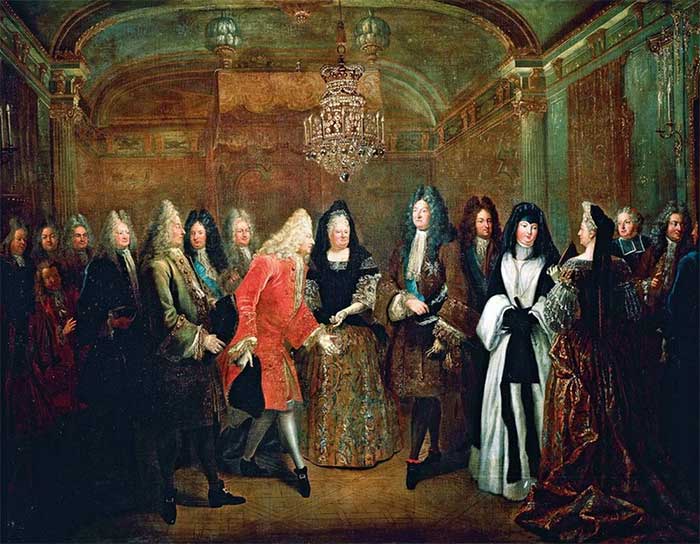Long before Dolly Parton (1946) famously said, “the higher the hair, the closer to God,” Emperor Louis XIV (1638 – 1715) initiated a unique men’s hairstyle trend that would go down in history, requiring officials to wear large, voluminous wigs.
Symbol of Status
In French history, Louis XIV is renowned as the “Sun King.” He was one of the most powerful and longest-reigning monarchs, ruling for an impressive 72 years and 110 days.
Surprisingly, this emperor, who seemed primarily interested in military affairs, paid great attention to fashion, particularly hairstyles. This obsession likely began with his father, the late King Louis XIII (1601 – 1643).
During the Middle Ages, in France, thin hair and baldness were considered signs of syphilis, a disease treated only with mercury, which had the side effect of causing hair loss.
In his youth, Louis XIII had naturally thick and long hair. However, by the age of 23, he began to lose his hair. Palace hairdressers meticulously collected strands of his hair to braid additional hair from outside, making it appear thicker and longer.
Despite the efforts of the late king and his hairdressers, his hair continued to fall out. Ultimately, he resorted to wearing wigs, and because the wearer was an emperor, the French court soon accepted wigs as a status symbol.
Louis XIV ascended to the throne in 1643 at the tender age of four, just when Madrid, Spain was the fashion capital of Europe. From his teenage years, he became enamored with luxurious dark clothing, favored red-heeled shoes, and took a particularly keen interest in hairstyles.
Like his predecessor, the emperor also began losing his hair at an early age. Before even becoming bald, he followed in his father’s footsteps, asking hairdressers to braid more hair into his own to create a fuller look. Eventually, like his father, the emperor could not avoid the fate of baldness by the time he turned 30. He abandoned efforts to save his hair and fully transitioned to wearing wigs.
Emperor Louis XIV’s wigs were known for their remarkable thickness and length. They consisted of tightly woven curls that reached down to his heels, crafted by his personal wig maker, Benoît Binet.
As time went on, Emperor Louis XIV invested even more in his wigs. His team of wig makers grew to 48. They treated each strand of hair like silk, intricately weaving and knotting them into complex patterns to create a voluminous effect, which was then carefully sewn onto a snug-fitting cap. Each wig required approximately ten regular-length wigs and considerable time to complete.
Following the emperor, numerous officials in the French court also donned wigs. Before long, wigs became a mandatory requirement for upper-class men, particularly judges and clergy. The wig-making profession exploded in popularity. In Paris alone, the number of wig makers increased from 200 in 1673 to 945 by 1771.
The Emperor’s taste dictated that wigs must be extravagant. French wig makers strived to create the tallest wigs possible. They paid exorbitant prices for real hair, making hair trading an economic focal point. Many rural women escaped poverty by selling their long hair, especially curly, long locks.

Voluminous and curly wigs were the standard for upper-class European men’s attire in the 17th century. (Image: Nationalgeographic.com).
Dominating European Fashion
Throughout human history, wigs have existed since before the Common Era. Many Egyptian mummies wore wigs, and in ancient Greece, upper-class women favored blonde wigs imported from Germany.
During the Middle Ages in Europe, the church encouraged natural hair and discouraged wig-wearing. However, the famous English queen, Elizabeth I (1558 – 1603), changed public attitudes with her collection of over 80 red wigs. Elizabeth I’s fondness for wigs stemmed from her own thinning hair. Thanks to her influence, European women no longer needed to hide or feel ashamed of wearing wigs.
The trend of wigs for men was brought to England by Emperor Charles II (1630 – 1685). In 1660, after a period of exile in France, he returned with numerous large, curly wigs to conceal his prematurely greying hair. The English elite, easily influenced by their ruler, quickly became devotees of voluminous wigs. They did not hesitate to pay as much as 800 shillings per wig, equivalent to approximately £8,000 today.
For many years, wig fairs were held throughout Europe. Young peasant women could dramatically change their fortunes with beautiful hair. After curly wigs, blonde or smoky-colored hair fetched high prices. In many areas, they were even more valuable than horsehair and goat hair, which were highly prized.
Despite their popularity, wigs presented many inconveniences for wearers due to their heat and weight. A complete wig weighed between 3 to 4 pounds (approximately 1.4 to 1.8 kg). Designed to be voluminous and curly, they did not fit snugly on the head and could easily fall off with a slight bow. Judges often had to pay attention to their wigs when entering court to avoid them becoming misaligned or falling off, which could disrupt the solemn atmosphere.
Moreover, wigs were also prone to catching fire. In an era when artificial light at night mainly came from candles, men with large, voluminous wigs could easily accidentally… combust and set their homes ablaze.
In 1715, Emperor Louis XIV passed away. Simultaneously, the trend of voluminous wigs came to an end. His son, Emperor Louis XV (1710 – 1774), detested the cumbersome, voluminous hairstyles and encouraged simpler, closer-cropped styles. During Louis XV’s reign, French subjects often dusted their hair to flatten it down and tie it neatly at the back of their necks.
After France, the remaining European countries gradually turned away from voluminous wigs. By the end of the 18th century, this men’s hairstyle trend had completely faded away.


















































